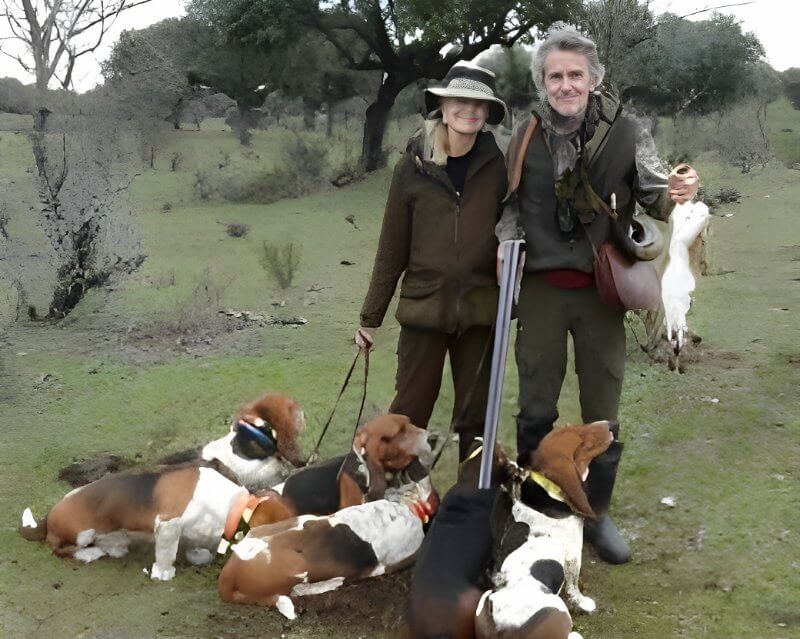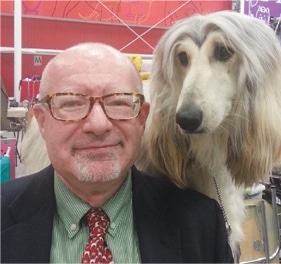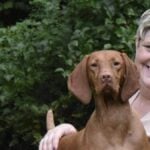
Home » Interview with Dr. Claudia Orlandi – Topsfield Basset Hounds
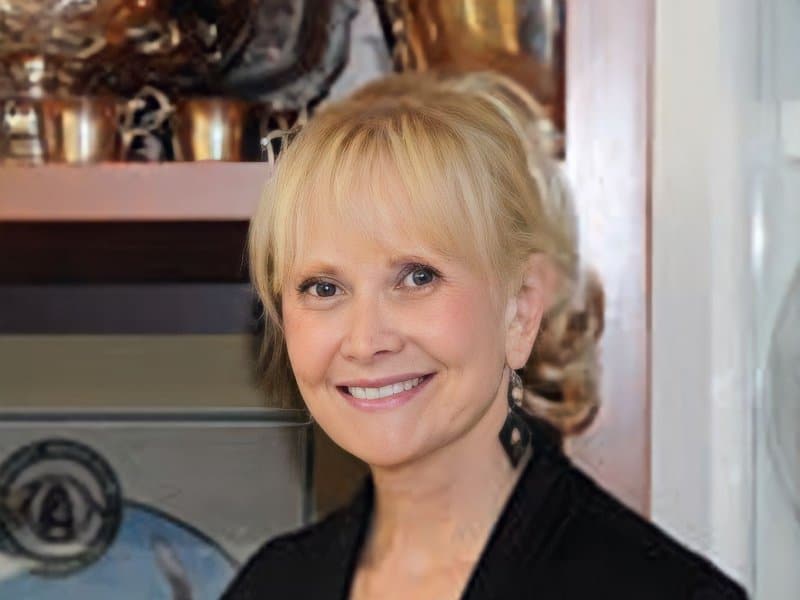
Dr. Claudia Orlandi: I was born in Waterbury, Connecticut, but spent my younger years on a large country property in Harwinton, Connecticut, where my life revolved around horses and dogs. At the age of 12 I joined an excellent 4-H horse club and was greatly influenced by our leader’s belief in hard work, commitment, and achieving excellence. Along with mastering horsemanship and learning stable management, our written tests and oral presentations on equine structure and movement not only helped develop my eye for a horse (and later, a dog) but also set standards that would shape my future as a dog breeder and educator.
Dr. Claudia Orlandi: Although we always had Poodles, when I was 14 years old my father, Edmund Waller, wanted to add a pet Saint Bernard to our family. We subsequently arranged to purchase a puppy from Betty Roberts’ Shagg-Bark Kennels in Tolland, Connecticut. The day we arrived at the kennel, Betty was not feeling well and asked her husband to take us to see the puppies. As luck would have it, the wooden barrier separating the pets from the show-quality prospects fell down, and the entire litter was running together. We picked out a gregarious male with good bone and a gorgeous head and named our newest family member Bowser Waller.
Early on, there was an eye-catching balance and something special about our puppy that spurred me to learn everything I could about Saint Bernards. I was familiar with equine structure, angulation, and movement, and after studying the AKC standard along with photos of top-winning Saints, I believed Bowser was quite beautiful. With my family’s encouragement, I took handling classes and started entering dog shows where I enjoyed success in the breed ring and as a junior handler.
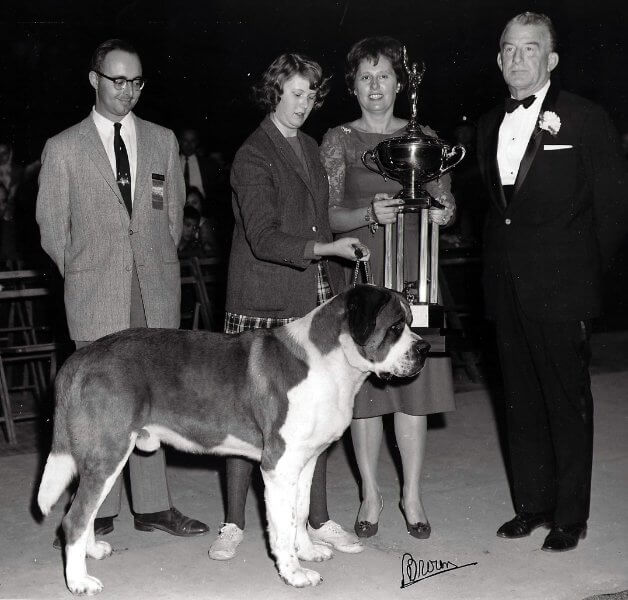
These experiences led to my lifelong love of the dog fancy. When I went away to boarding school, we gave Bowser back to Betty where he ended up becoming a multiple Best in Show-winning dog, handled by Bob Forsyth. He was indeed one of the best Saints she had ever bred and I have often wondered what would have become of my life if that barrier between the pet- and show-quality puppies had not fallen down!
Dr. Claudia Orlandi: After falling in love with a Basset Hound at a horse show in 1985, my husband, Dom, and I purchased Salmon Brook Sweet Emma from Michele Maulucci’s Salmon Brook Kennel in Vermont. Although she worked with show bloodlines, Michele’s passion was pack hunting. Emma, who proved to have a good nose, soon formed part of the Salmon Brook pack along with several other Bassets we subsequently purchased from the Timber Ridge pack of Maryland. Michele mentored us in the fabulous world of the hunting Basset until she and her hounds relocated to Maine in the early 1990s at which point we decided to breed Basset Hounds for the show ring. We had just retired a record-breaking Morgan English Pleasure horse from the show circuit and this, combined with our prior dog show experience, eased our transition into the world of conformation Basset Hounds.
The established breeders with whom we wished to work not only offered us access to their valuable bloodlines but also their ongoing support. These early mentors included Eric and Erica George (Strathalbyn Bassets), Penny and Randy Frederiksen (Ambrican Basset Hounds), Jinny and Frank Kovalic (Stoneybluff Bassets), and Pat and Ted Ellis (Bone-A-Part Basset Hounds). In addition to providing advice and pedigree histories, they introduced us to other important breeders with whom we would later work, including Claire “Kitty” Steidel (Sanchu Basset Hounds), who would become a valued partner and co-breeder.
Joy Brewster, a prominent professional handler who had shown for Eric George, also became an early influential mentor. For several years I was her part-time assistant at shows, and in addition to teaching me how to present a Basset Hound, she taught me the ins and outs of the dog show world. Joy had a balanced take on winning and losing, and one particular weekend after I experienced an especially disappointing loss, she said, “Claudia, everybody deserves their day in the sun.”
It was a gracious comment about that day’s winner and a lesson in good sportsmanship. I still remember it and have often repeated this phrase to others. Joy’s strict rules and attention to detail were reminiscent of the high standards of my 4-H horse club and working with her contributed greatly to my success as a breeder.
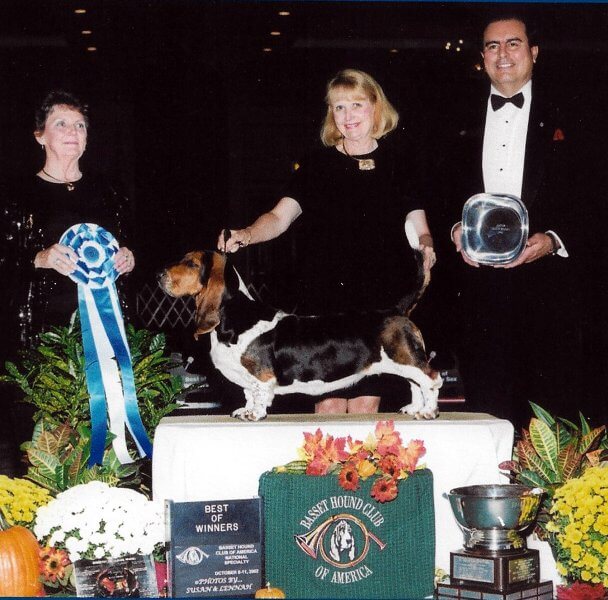
Dr. Claudia Orlandi: Our highest priority is health, followed by breeding Basset Hounds that conform to the breed standard and are capable of performing their original function, which is to follow the scent of rabbit and hare. I can’t overstate how strongly I feel a dog breeding program can benefit from not only having an eye for a dog and avoiding kennel blindness but also understanding genetic principles, which includes knowledge of how genes pass from parent to offspring, breeding systems, the pedigree, and selection. We began working with three bloodlines and from these lines determined the dogs with the best breeding values based on phenotypic selection. Our aim over time was to create and maintain two or three distinct family lines within the Topsfield program. This approach avoided breeding ourselves into a corner if a particular bloodline did not nick or produced a health problem.
Breeding success begins with having a clear picture in mind of the dog you are trying to produce. Our ideal Basset Hound is a correctly proportioned and angled dog whose individual parts fit together seamlessly, setting the stage for smooth, powerful, effortless movement as called for in the standard.
Having visualized our ideal, our goal was to bring this picture to life using a palette of bloodlines. Given the importance placed on movement in our breed, an ongoing challenge is producing Basset Hounds with angles that approach 90 degrees between shoulder blade and upper arm, and 90 degrees between pelvis and upper thigh and upper and lower thigh. Because a dog’s phenotype provides reliable clues to the genes it carries for a trait, to improve angulation we focused on mating together animals with good health status in which, importantly, both front and rear angulation came as close as possible to 90 degrees.
It bears repeating that health has been and continues to be our highest priority, followed by selecting for whatever trait(s) we are attempting to improve. Our best results came from loose linebreeding and outcrossing because it gave us more time to observe how our bloodline combinations were progressing and allowed us to change direction when necessary.
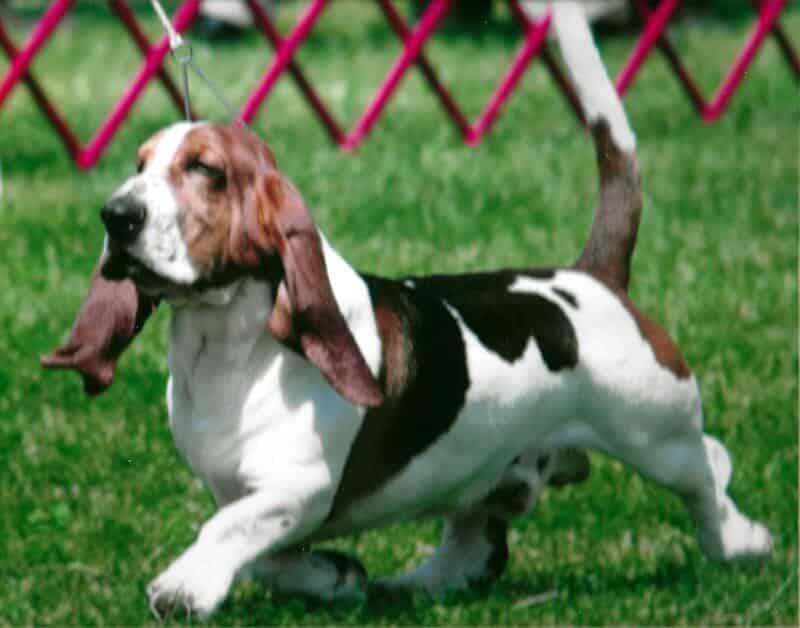
As we moved forward, we worked with a number of bloodlines, from time to time discovering wonderful nicks, while other matings simply did not work. Our program continues to employ light linebreeding and outcrossing and still adheres to maintaining individual family lines. To improve genetic variation and lower the risks of producing disease as well as effects of inbreeding depression, we do not inbreed. In controlling genetic defects, honesty about health problems has been a cornerstone of our breeding philosophy.
Dr. Claudia Orlandi: Ours is an informal hobby kennel on 200 acres in northern Vermont. We can comfortably house approximately 40 Basset Hounds. The dogs have 24/7 access to long outside runs, which provide good exercise. A training room with a ramp and mirror is used for preparing the show dogs.
To assess hunting potential, at 10 weeks of age puppies are started in the bunny barn, where two rabbits live and run freely. Cinder blocks and a configuration of tree trunks provide shelter and hiding spaces. The bunny barn allows us to assess a pup’s interest in rabbits as well as its tendency to give voice and put nose to ground. Because they usually see rabbits at some point during this exercise we only bring them to the barn two or three times to avoid dependence on sight chasing.
After bunny barn training, puppies are worked in a small outdoor pen where we can begin to more fully evaluate their ability to follow a line as well as their insistence and searching capabilities. We gradually move to a slightly larger pen and finally to a 6-acre field. Retired Bassets and those not kept for breeding are placed in loving pet homes. Sue Frischmann (show manager/handler), Linda Panella (kennel manager), and Candy Carswell (handler) have all been with me for close to 30 years and we would not have enjoyed the success we have had without their hard work, talent, and loyalty.
Dr. Claudia Orlandi: Topsfield has produced over 180 champions and has won over 140 Bests in Show and more than 500 Group Firsts. They have been Number One All-Breed Basset Hound for 17 out of the last 21 years and hold a number of breed records. Ch. Topsfield Bumper Cars CD, ROM, winner of 45 Bests in Show, is the top Group-winning Basset Hound in breed history with 250 Group Firsts. He was Number One Hound All Breeds in 2001 and Number Two Hound All Breeds in 2002.
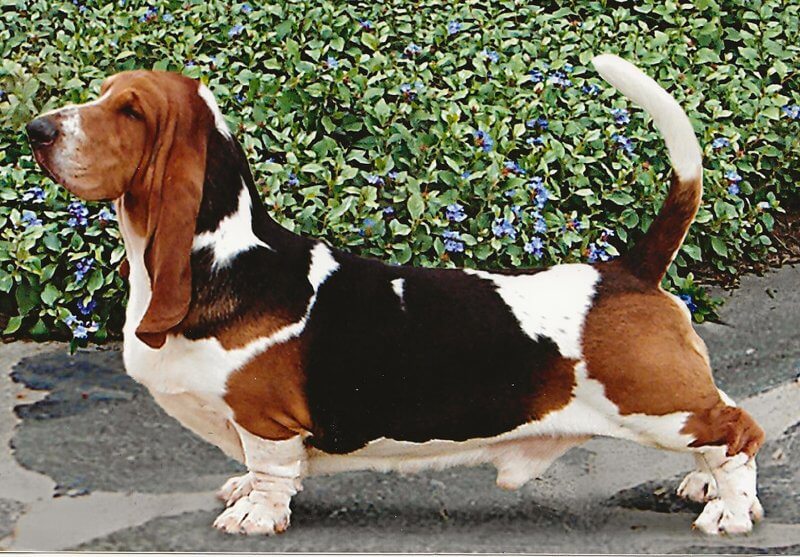
Ch. Topsfield Beethoven was Number One Basset Hound in 2005 and 2006 All Systems and Number 2 All-Breed Hound; he was Number 11 All-Breed Dog in 2006 as well as the Purina Hound Show Dog of the Year.
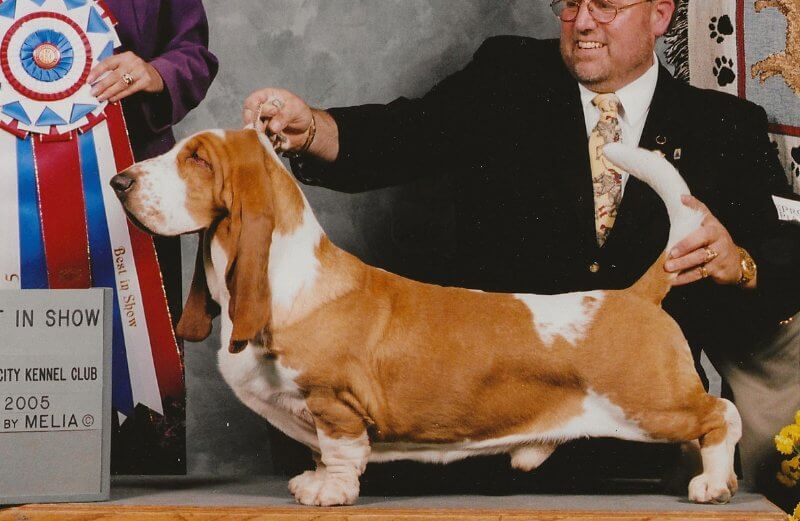
Beethoven’s daughter, Ch. Topsfield-Vision Silver Noodles CD BN RA NAP NJP CGC TDI, bred by Nancy Richmond, Lisa Brackett, Anne Testoni, and Bjorn Zetterlund, is the top-winning bitch in breed history.
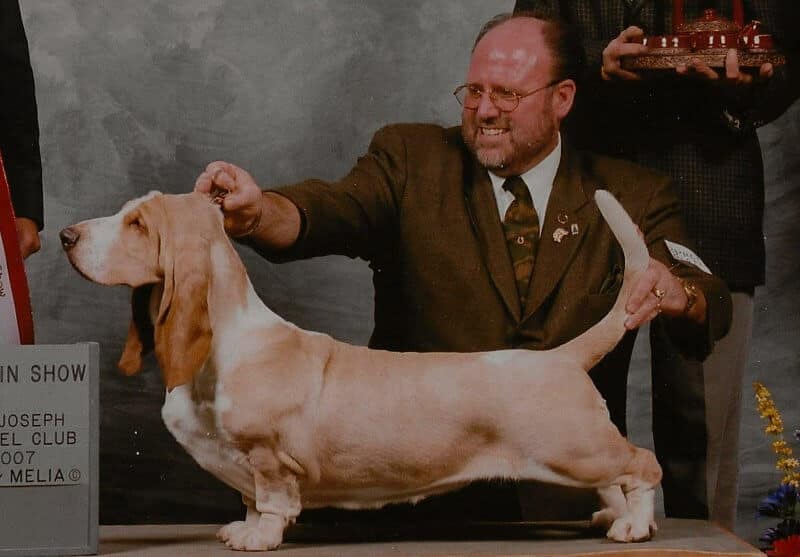
All of these foregoing dogs were expertly handled by Bryan Martin. Ch. Topsfield Bumper Cars, Ch. Topsfield Sanchu Pop Art O’Bridi, Ch. Topsfield Sanchu Eenie Meeny Miny Moe, Ch. Topsfield Sanchu Poppycock, and Ch. Jollytime My Way At Topsfield are BHCA Best of Breed National Specialty winners. Ch. Topsfield-Sanchu King of Queens and Ch. Topsfield Sanchu Cannoli were sent to Chris Lawrence’s Beauchasseur Kennels in Australia and they and their get have had great success in that country.
In the whelping box, Ch. Topsfield Jingle Bells, ROM, is the top-producing Basset Hound dam in breed history with 21 titled offspring. With regard to our most influential stud dog, no one Topsfield male takes top billing in this category since we have strived not to over-use any one particular dog. We have always avoided what may be called a “popular sire,” whose potential to pass on hidden recessive genes for genetic defects can be detrimental not only to a breeding program but to a breed population as a whole.
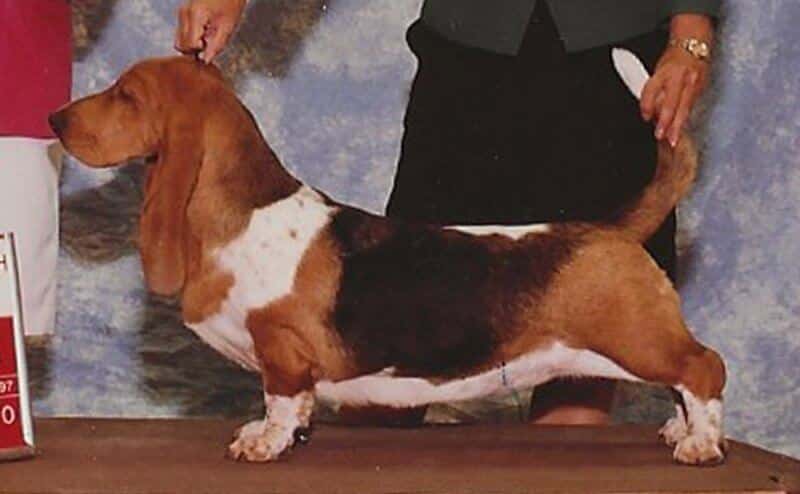
Dr. Claudia Orlandi: Relatively speaking, the Basset Hound is quite healthy compared to other breeds and overall health has perhaps even improved in past years, thanks to the availability of DNA tests for a broader range of diseases as well as a greater openness and honesty about health problems. Having knowledge of carriers and dogs affected with a genetic defect is the most important step in being able to successfully control disease in a breeding program.
On the conformation side of things, many important and influential breeders have passed away in the last 10 to 15 years, resulting in fewer dogs being produced for the show ring. Focusing on the overall breed type (correctness) of the Basset Hounds we are currently producing and showing remains an even higher priority and is more important than ever before.
The sport has changed greatly since you first began as a breeder-exhibitor. What are your thoughts on the state of the fancy and the declining number of breeders? How do we encourage newcomers to join us and remain in the sport?
The decline in breeders is certainly discouraging. I have always felt that education is a key to attracting newcomers and many good courses are available on AKC’s Canine College website. Successfully breeding healthy purebred dogs requires: (1) a working knowledge of genetics; (2) avoiding kennel blindness; and (3) having an eye for a dog, which involves understanding principles of anatomy and movement. Learning genetics is a step-by-step process and the average breeder is best served by following a systematic course of study.
Anyone can apply rules of genetics in a breeding program, and although some scientists disdain simplification, making genetics easy-to-understand has proven to be the most successful approach for the lay person dedicated to breeding dogs. Similar to learning our ABCs before we can read and write, a dog breeder first needs a practical knowledge of how genes are passed from parent to offspring in order to better understand breeding systems (inbreeding/linebreeding and outcrossing), the pedigree, and the selection process. Because it increases confidence, pride, and a sense of accomplishment, breeder education programs that award a Certificate of Achievement upon fulfilling course requirements are more likely to encourage participation on the part of newcomers.
Dr. Claudia Orlandi: Following the death of my first spouse in 2007, I married my now husband, Guillermo, 10 years ago. Guillermo has bred hunting Bassets in Spain under the Lebrera prefix for over 50 years, and since our marriage, we have focused on breeding the dual champion Basset Hound, which is one that has earned a championship title in both conformation and field trial competition. Topsfield’s foundation bloodlines originated from hunting stock and Guillermo and I believe strongly in the importance of maintaining a breed’s original purpose. Our focus going forward is to keep meeting the worthwhile challenge of breeding champion Basset Hounds for the bench and field.
Dr. Claudia Orlandi: Upon earning an MA and PhD in Spanish in the mid-1970s, I began course work toward a second PhD, this time in psychology at the University of Vermont. Although commitments to my family’s business curtailed plans for completing another doctoral degree, my studies in experimental psychology and the sciences furthered my interest in genetics.
For over 50 years, my family’s FoodScience Corporation, which oversees Vetri-Science and DaVinci Laboratories of Vermont, has been a pioneer in the field of preventive medicine through researching and formulating nutritional supplements for veterinarians and physicians. Although I sold the company in 2021, my experience in the field of canine preventive health and a love of academics and teaching continue to improve my life as a breeder. My husband’s and my life revolves around our dogs but we also enjoy hunting wild boar and fox in Guillermo’s native Spain, in addition to traveling, antiquing, reading, and going to the movies!
